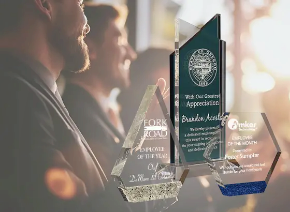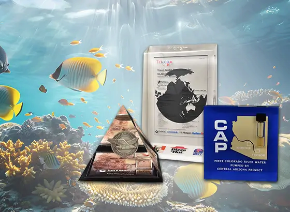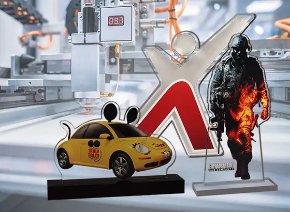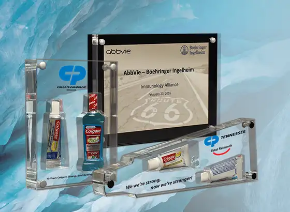You’ve seen them before… acrylic blocks with an object gracefully floating as if suspended effortlessly inside crystal clear plastic. Often you will see them in gift shops with a bug or some other regional specimen that you can purchase as a memory of your trip.
But did you know it’s more common than not to have personal treasures and business accomplishments cast inside a Lucite® Embedment? From personal memories like sea glass from your family beach trip to professional achievements like your retired police badge – Lucite® embedding offers a level of protection to your treasured possessions that no other compound can match.
Crystal-clear by nature and bubble free when cast properly – the compounds that make up a custom Lucite® embedment offer a way to display your achievements for a lifetime of protection.
The embedment process…
The first thing you should know about acrylic embedments is that not all processes are the same. The two most common types of embedments are polyester and Lucite®, and the latter is by far the best way to cast any item you truly care about. Let’s take a look at the two embedment processes.
Polyester Resin Embedding
Designed originally for the study of animal, plant, and microbiological samples. A water-soluble resin of methacrylate and polyester – you can often see this type of acrylic embedments in gift shops with a scorpion or spider encapsulated.

A less complicated process than Lucite® embedding – polyester is often used by do it yourselfers in a garage type environment. A two-part process of polyester casting resin and a liquid curing catalyst is used and poured in a similar fashion to Lucite™ by applying a layering process that permits cast objects to be suspended while pouring additional layers. Once all of the casting layers are poured – polyester often takes several days to cure thoroughly.
There are some potential drawbacks to polyester casting however, including a lack of clarity due to slight yellowing caused by the addition of a curing catalyst plus bubbling and layering that can often occur due to the lack of pressure needed to force the bubbles out of the mold and bind the poured layers properly.
Lucite® Embedding
On the other hand, Lucite® is clearly the way to go if you want crystal clear, bubble free acrylic. This is a process of two compounds – a liquid monomer and a powdered polymer mixed at ratios of 70/30 to 30/70 based on the product to be embedded. You can learn more about the detailed casting by visiting our Array™ Acrylic Embedment page.
Similar to polyester embedding, acrylic is poured into molds and layered allowing objects to float as additional layers are added and prepared for curing. The primary difference between the two processes is the addition of heat and pressure added during final curing in an autoclave. Lucite® embedments are cured with the addition of nitrogen at 140 psi and a starting heat of 170˚ degrees Fahrenheit for a period of approximately 8-10 hours. During this time, the poured monomer and polymer mix generates its own heat causing molecular chains to form which bind and clarify the Lucite™ as the pressure forces the bubbles out.
This is the simplified version of a complex chemical process that produces crystal clear acrylic embedments. We offer an interesting time lapse video that walks through the process of casting, curing, and finishing retirement police badges that you might find interesting.
Highlighting a challenging embedment project…
That said, the Lucite® process still requires skilled hands to do the job right. We recently embedded a large display piece for a client who wished to have mementos from his anniversary trip cast inside Lucite® for his wife. After a relaxing beach trip, they came home with conch seashells and a few pieces of coral that had washed up on shore.

A large casting with a finished size of 4 1/2” deep x 5” high x 10” wide created quite a challenge for our casting team. The main concern being the voids inside the shells and coral pieces that could potentially introduce air and impurities. After preparing the molds and cleaning the items thoroughly the fun began.
Determining the optimal layout creates a visual of what the embedment will look like when complete.

Pouring the first compound layer suspends the conch shells and coral. Because of the weight of the items extra time was needed in curing to keep the items from settling in the mold.

Filling the voids helps remove as much air from the items as possible to keep bubbles from escaping while curing.

A second layer of compound is poured and allowed to gel for final aesthetic placement.

Finally, the third layer is poured to encapsulate and protect all of the items in Lucite® which will become crystal clear when heat and pressure are introduced inside an autoclave.

Though casting takes the bulk of the responsibility for ensuring items are cast clearly and bubble free – it’s the finishing process where the detail magic happens. Planing, sawing, edging, and polishing are just a few of the steps required to take the basic casting from a raw milky white state to the final level of perfection. Our skilled craftsmen create custom acrylic works of art every day that are destined to be a conversation piece for years to come.
Finished views of the embedded pieces

Some interesting acrylic embedment ideas…
With over 35 years of embedding experience, US Acrylic Awards clearly offers a premier level of Lucite® awards embedment. Manufactured in the USA – our creative teams take pride in every object we cast into Lucite®. Some of our favorite projects include medical devices, vaccine vials, IPO offerings, real estate deals, patents, coal, coins, sea glass, and component parts just to name a few.
At US Acrylic Awards we appreciate a challenge and look forward to finding solutions to your embedment ideas. Let us know how we can help protect and show off your hidden treasures.
Written by noptim… unleash the power













